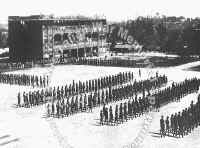 |
"By this time I had
worked out a pretty safe way of carrying the camera. Being a
folding model, it was fairly flat, about five inches long, three
inched wide and about an inch and a half thick. To take a picture
you had to open up the front of the camera and pull out a bellows
which gave you sufficient |
| depth
of focus. I noticed that a lot of the Japanese wore a kind
of kidney belt, a bit like a scaled down version of those sashes
worn by Sumo wrestlers. I fashioned a thick canvas kidney belt,
with one important difference. It had an inner pocket which could
be closed with a couple of press studs. I used to carry the camera
in that, snuggled into the small of my back. If I had a shirt on,
I'd let that fall over it. It wouldn't have survived a really
thorough search but, thank goodness, that never happened while I
was actually carrying the camera." George Aspinall |
Note
that Selarang Barracks was where the Australian contingent was
incarcerated right from the start and for the whole of the rest of the
war. Contrary to popular misconception the
POWs were not locked up in a traditional prison. It was a prison camp of
considerable size (thousands of acres) and most of the POWs were housed
in former British Army barracks, which is what Selarang was. Prisoners
went out through the wire and returned on a regular basis. Once they
even smuggled in a full size upright piano.
 |
The
Australia Day march in Selarang Barracks 1943. |
Changi was not a particularly bad camp
by comparison to other Japanese run POW camps. With the exception of the
Selarang Incident overcrowding was
not rife. That is not to say that it was not a bad place, just that it
was less terrible than it has been portrayed and less terrible than others. Compared to the camps on the Thailand to
Burma Railway it was a 'country club'.
In 1943 in New Guinea the Japanese
were reduced to cannibalism including the killing and eating of
prisoners as well as eating the flesh of their own dead. They are also
reported to have used Australian prisoners as bayonet practice targets.
Compared to those atrocities Changi was not bad.
| To be chosen to join a working
party meant that the life of relative security and comfort at
Changi was to be exchanged for a life of endless toil under the
most degrading conditions, endless, that is to say, unless death
mercifully intervened. It was hardly surprising that everybody
feared being sent on the working parties and intrigued
ceaselessly to avoid this fate. Extract
from Changi History |
Map of Changi Area 1942
thumbnail, click to
enlarge

 
|